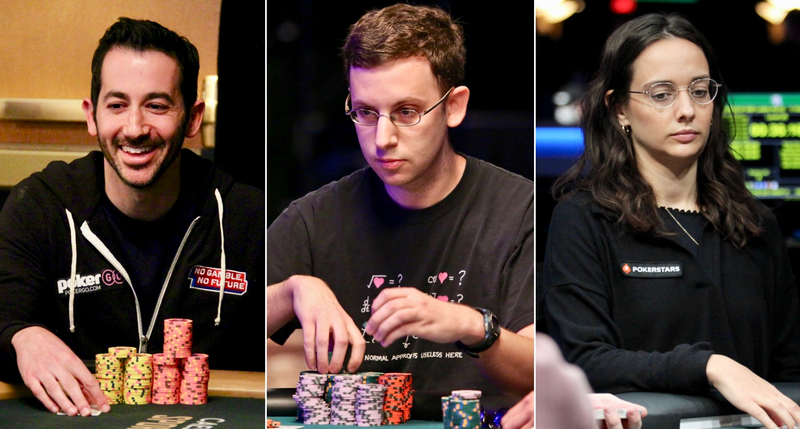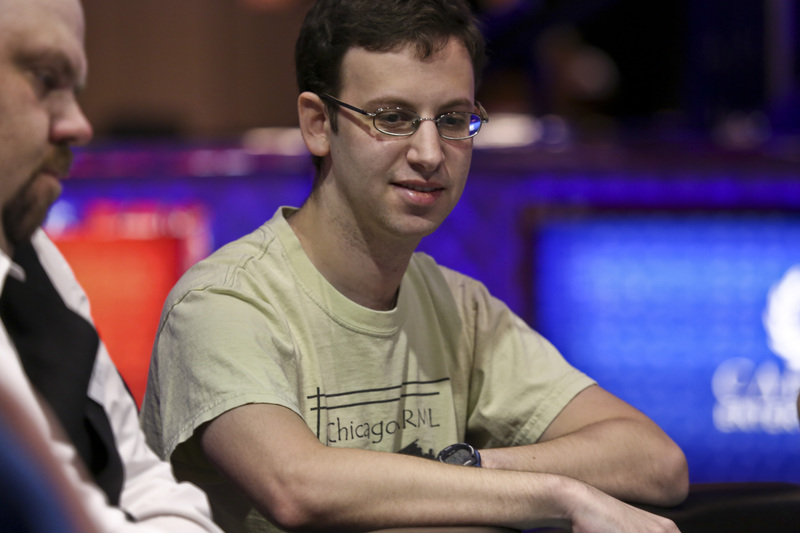






Poker Strategy: Adjusting Preflop Ranges In TournamentsThree Top Players Share Their Tips For Successby Craig Tapscott | Published: Dec 01, 2021 |
|
|

The Pros: Jeff Platt, Scott Abrams, and Marle Cordeiro
Craig Tapscott: What do you think is essential for a tournament player to understand regarding preflop ranges from different positions?
Jeff Platt: I feel like preflop range studying is such an important part of the process in becoming a decent multi-table tournament player. What I recommend to players who are just starting out in tournaments is to try to become very familiar with your 15 to 30 big blind preflop play, since that stack size will probably be the most common you’ll see in most of the lower buy-in events.
Once you become familiar with the “correct” preflop ranges, I think then you can adjust them based on the quality of opponents at the table. For example, if I have a very tight/recreational player-heavy table, I’d maybe adjust my early position ‘Raise First In’ range to include 5-10% more hands. If I have very good players at the table, I’d probably stick to GTO ranges throughout.
Three-betting spots are also extremely important. For the most part, amateurs are three-betting the hands they shouldn’t be, and just calling with hands they should be three-betting.
 Scott Abrams: I guess the biggest thing I would point out is how much a good exploitative pro will change preflop ranges based on their table opponents. There are charts available describing what hands you “should” play from each position (such as 6-6+, A-Q+ from UTG, etc), and these charts are usually fine as a starting point. But a good pro can (and should) adjust a lot.
Scott Abrams: I guess the biggest thing I would point out is how much a good exploitative pro will change preflop ranges based on their table opponents. There are charts available describing what hands you “should” play from each position (such as 6-6+, A-Q+ from UTG, etc), and these charts are usually fine as a starting point. But a good pro can (and should) adjust a lot.
For example, if players to your left are tight and passive, you could even raise 100% of all small blind, button, or cutoff hands and make a profit. Raising to 1,500 at 300-600 blinds (with 600 BB ante) is risking 1,500 to win 1,500. If it gets through preflop, say one-third of the time, you only need to win a small percent of the remaining two-thirds of hands to show a profit.
If the table is very passive, you could play high implied odds hands like small pairs and suited aces that are normally a fold in early position. And if the table is super aggressive, you can fold most marginal hands that are normally worth playing, so that most hands you play you can continue against a three-bet.
Of course, these adjustments are dynamic; they are constantly shifting. If I see a player open the button against my big blind and table 6-2 offsuit at showdown, then I will want to three-bet this player more in the future to punish light steals. They may adjust by playing fewer hands, or four-betting wider against my three-bets. The ranges from each position are always shifting.
Overall, preflop ranges are about adjustments more than they are about set ranges from each position.
Marle Cordeiro: In an MTT, preflop ranges can drastically change based on your stack size, the stack sizes behind you, and the stage of the event. Being willing to adjust your opening ranges based on these three factors is critical to good tournament play.
The playability of a shorter stack is also sometimes overlooked by newer players. You can still three-bet and defend your big blind very wide (due to the ante) on a sub-25 big blind stack. But being shorter can handcuff you in spots where it can feel uncomfortable folding beautiful looking hands.
You can also do a fair amount of “trapping” on shallower stacks (especially in position) as the stack-to-pot ratio won’t be very high post-flop, thus denying equity and getting value preflop isn’t as much of a concern.
Especially in live poker, people tend to under bluff in three-bet, non all-in spots, so you can over fold when they do. They also tend to under defend their big blind, so you can open in late position very wide. Overall, people also don’t trap enough with the top of their range and to induce shorter stacks behind them. This leaves their calling range relatively capped and you can exploit that post-flop.
Craig Tapscott: What were some of the key lessons or insights you learned regarding tournament play as your game evolved to where you are today?
 Jeff Platt: As I mentioned earlier, having your preflop ranges down, especially in that 15 to 30 big blind range, is pretty essential. That’s been so important in my approach to MTTs.
Jeff Platt: As I mentioned earlier, having your preflop ranges down, especially in that 15 to 30 big blind range, is pretty essential. That’s been so important in my approach to MTTs.
In the buy-ins I play, I feel like selective aggression is also extremely important. I could play ABC poker, and maybe have a really good chance to cash every time. But in the past couple months or so, I’ve tried to ramp things up a bit and shift strategies to go for the win and deep runs.
Finally, I think stack preservation is so incredibly important. In the old days, it was “well, I have less than 20 big blinds, so I got to go all-in I guess.” But now, there’s just so much you can do off a short stack. I’m happy to defend the big blind in certain spots with a stack of less than 10 bigs, I’m happy to not go all-in and three-bet light off a 20-big blind stack in certain spots, and I’m happy to just limp in off 15 big blinds in the hijack or cutoff in certain spots instead of shoving.
Scott Abrams: My thoughts playing MTTs: 1) Balancing stack preservation versus aggression. It’s a constant balancing act, but you need to weigh both sides of the fulcrum perfectly. On one hand, you need aggression to capture value, to get hands to fold that have equity, etc. On the other hand, flipping for chips is not ideal (especially late in tournaments) and you need to save chips wherever possible. Try to find any patterns for when opponents are weak, (and then ATTACK!) but risking chips beyond that should be reserved for strong hands.
2) Early levels are important. Every year there is an argument about WSOP structures and whether they are too fast or if the early levels are too slow/unimportant. I personally prefer slower structures (though I know many good players who disagree). I don’t think it’s coincidence that my deep WSOP runs (like third this year at $1,500 mixed Omaha and fifth in 2019 in $1,500 PLO8) were in tournaments where the starting stack was over 100 big blinds deep for multiple hours on day one. I find tournaments that start deep have a much higher concentration of pros at the final few tables.
In early levels, you learn the most about your opponents, and you can discover their tendencies before pots get too costly to you. The poorest players have the most chips on average at level one. Also, many pros late-register while the recreational players are excited to start early, so the softest tables are definitely at the beginning of any tournament. Here, you have an opportunity to build some cushion so that a big cooler later in the tournament won’t bust you. Moreover, winning chips early means winning even more chips later; a good player will definitely win more big blinds per 100 with a bigger stack than with a smaller stack (more room to maneuver, and more chips to win with those huge hand double ups).
3) Don’t miss hands. This is similar to point two, but I see way too many players skip a few hands to smoke, eat, talk to friends, whatever. If your chip stack is worth $2,000 and you blind out 5 percent of your chips, you just lost $100, and that’s ignoring the ROI from those missed hands.
 Marle Cordeiro: Before playing tournaments, I was a cash game player for most of my poker life. That can be a blessing, as playing deep stack cash games forces you to have solid fundamentals about the game. A lot of that does translate to MTTs, but I also had to unlearn some bad cash game habits as well.
Marle Cordeiro: Before playing tournaments, I was a cash game player for most of my poker life. That can be a blessing, as playing deep stack cash games forces you to have solid fundamentals about the game. A lot of that does translate to MTTs, but I also had to unlearn some bad cash game habits as well.
One big adjustment was playing wider preflop. Because of the ante, you’re forced to defend very wide and take trash hands to battle post-flop.
The second lesson I had to learn was that there is still so much maneuvering that can be done, even with short stacks. (Although coming from cash games everything feels short.) Three-betting not all-in preflop, min clicking post-flop, and tiny leads are all par for the course in MTTs. It feels very uncomfortable when you’re used to sitting 300+ big blinds deep.
Lastly, I’ve learned the hard way that you can’t win an MTT on day one. Patience is key in these big field events. Yes, accumulating chips early on when the field is softer is great, but there’s no need to battle the best player at the table or get into ego wars day one. Save that for later. ♠
Jeff Platt started his career covering the Dallas Mavericks and San Antonio Spurs of the NBA before finding his way into poker media with PokerNews and as a broadcaster and host for PokerGO. As a player, he has competed on Poker After Dark and made a deep run in the 2015 WSOP main event. He most recently finished fourth in a WSOP $1,000 no-limit event for $160,000. Follow him on Twitter @JeffPlatt.
Scott Abrams has been playing poker for more than a decade, grinding his way from $1-$2 games to the $80-$160 mixed games in Las Vegas. He has nearly $1 million in career tournament earnings, including a 12th-place finish in the 2012 WSOP main event for nearly $600,000. Find him on Twitter @weirdchess1.
Marle Cordeiro Spragg is a regular high-stakes cash game player who has gained a sizable following thanks to her YouTube channel MarlzTV. The PokerStars ambassador has also appeared on Poker After Dark and recently final tabled the Ladies Championship at the 2021 WSOP. She can be found on Twitter @MarleSpragg.
Features
Tournaments
Strategy